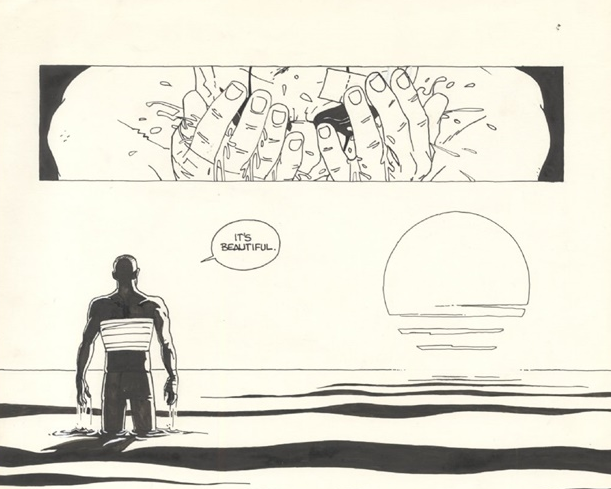 My year-long look at the work of Rumiko Takahashi continues here. A great creator deserves a whole year of examination! You can find all of the posts here.
My year-long look at the work of Rumiko Takahashi continues here. A great creator deserves a whole year of examination! You can find all of the posts here.Written by Rumiko Takahashi
Illustrated by Rumiko Takahashi
Viz
As regular blog followers know, I don't solely read manga. It's about one third of my reading in any given year, though I tend to review it a bit more often than other comics I read because people seem to like talking manga online more than any other type of comic for some reason. (Maybe it's just the people I hang out with, like those involved in the Manga Movable Feast.) At any rate, I started my time in comics as a huge fan of superhero comics, especially the older stuff from Stan Lee, Jack Kirby, Steve Ditko and others. Many of the writers and artists I liked best were schooled in their way of writing from these Kings of the Silver Age.
What that means is I grew up reading comics where things happened quickly. Big events might go two issues in a row, but never more than three. You could be facing nuclear war on page three and be finished by page eighteen. Not always the best way to tell a story, but it worked more often than not.
Comic writers don't do it like that anymore. Everything is written for four-five-and-six volume trade paperbacks, with a single plot idea teased out as far as possible with splash pages and dialog. Even newer manga seems to share this problem. Even in series I like I tend to find myself flipping around to get to the meat of the matter, if the art isn't knocking my socks off.
But what does this have to do with Rumiko Takahashi, you ask? Well, as I went over some of the really big concepts covered in just a few chapters within the pages of volumes 11 and 12, it struck me that Takahashi writes Ranma 1/2 at the same racing pacing of the old superhero comic books. Her story style has a lot more in common with Thomas and Tezuka than it does with Bendis or Kubo.
 Think about the first story arc in volume 11, where Ranma learns that Shampoo has a soap that can prevent him from changing between a boy and a girl ever again. This is a chance for Ranma to be cured once and for all. You'd think that would take up at least one entire book, right?
Think about the first story arc in volume 11, where Ranma learns that Shampoo has a soap that can prevent him from changing between a boy and a girl ever again. This is a chance for Ranma to be cured once and for all. You'd think that would take up at least one entire book, right?Nope. All done in about 80 manga pages, which isn't even half of a standard 200 page manga trade. Ranma frantically chases Ryoga with Shampoo in tow, making her an unlikely ally as they try to wrangle the bar from his piggy paws. In some of the funniest moments in the past few volumes, Ranma and Shampoo pretend to be twins "Kew" and "Pid" and Ranma even allows Ryoga to date Akane (in what is a recent pattern of his seeming to care less about Akane and other men) all in the name of getting the soap.
The sequence keeps getting progressively sillier, with Akane feeling bad for whoever ends up dating Ryoga and Shampoo making comments about mail order products, but what really drives the comedy and action here is that it's happening at manic, Marx Brothers in their prime speed. Written today, this would have gotten slung out for another 100 pages, lost much of the charm and all of the comic timing. Takahashi's use of old-school comic book pacing is what makes it all work.
Not content to finish things off with some short, silly stories, Takahashi slams her cast into yet another big event for Ranma--the loss of his fighting ability. It's "Ranma No More!" as Happosai (in his first appearance where I wasn't nauseated) puts the fix on Ranma for foiling his perverted schemes. With Ranma powerless, all his enemies come out to play, hoping to finish him off. (Come to think of it, this is another older comic book idea that Takahashi is using to good effect.) Ironically, it's Ryoga, Shampoo, and Cologne who hold the key to helping Ranma--provided he can live long enough to fight his way to a cure.
Now of course we know Ranma will be back to normal, but again, it's the speed with which are back to the status quo that's quite startling by the standards of just about twenty five years later. While we run about the equivalent of a full volume this time, that's still lightning fast, and this time, it's not because the comedic pacing needs to be at full speed. Instead of long, extended battle scenes with Ranma's foes, they only get small sections of battle. Even the fights with Happosai are pretty short, finishing up without a lot of give and take between the two foes.
If anything, I'd argue that this arc doesn't get the space it deserves, for being such a potentially big thing. However, that's just not how Ranma 1/2 works. Twelve chapters is all it gets, and we're off to the races with comedic demonic cats, Akane's inability to swim, and the lengths a sick child will go to keep a human-panda hybrid who likes to mooch off rich people. Rumiko Takahashi just isn't one to stay on the same part of a story (for better or worse), even if she isn't afraid to use recurring themes.
A few words about the Powerless Ranma arc before we move on for the week. This story really struck me as being different for two reasons. First and foremost, it has by far the least comedy of any Ranma arcs up to this point. There are still jokes and things we are meant to laugh at, but the tone is darker and more serious, as the cast comes to grips with the idea that Ranma can't fight even if his life depended on it. Ranma's uncaring attitude is shaken as he flees--maybe to train, but maybe just because he can't stand the idea of losing. Usually at the head of the joke parade, this Ranma has a lot on his mind, and it's not liberated until he's gleefully battling anyone in sight.
Secondly, Ryoga really comes into his own as a sympathetic character who has more depth than the other rivals, something I think Takahashi has set up when you look back on him. Of all the other cast members, he's the one that wouldn't bother the reader if he gets his way and has a fling with Akane. He's becoming less and less a source of ridicule as time goes on. Shampoo and Cologne also come off here as less annoying and more part of the Ranma Family. The dynamics here bear further investigation in later volumes, as I study these stories probably far more than they should be.
Lastly, as a rule, the stories in Volumes 11 and 12 seem to start moving away from Ranma actually caring about Akane, while Akane herself seems to move closer to Ranma. He's far quicker to insult her, and we get more internal and external comments from Akane that make Ranma's actions here seem particularly cruel. I'm not a big fan of male-female insult comedy, and it just doesn't play well for me here, especially against the more serious backdrop. If the point is that we'd rather see her with Ryoga, then it's working, because he's definitely classier here than the star of the show.
Swinging from slapstick comedy to personal reflection and danger, as we enter the second third of Ranma's story, it's interesting to compare the storytelling differences from an era that really wasn't all that long ago. For whatever it's worth, maybe I'm just old school, but I definitely prefer the quick changes of Takahashi to the padding of Geoff Johns. Tell the story in the space you need, not in what will fit best on the shelf at Barnes and Noble or get you a multi-book contract with Viz. I'd take shorter bigger stories like the ones in these volumes any day!
Next up, we'll take a brief break from Ranma 1/2 to examine One Pound Gospel for a few weeks. After all, there's far more to Takahashi than just Ranma!







